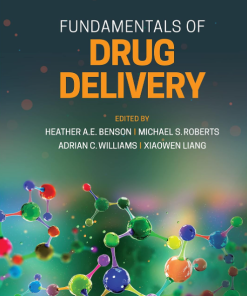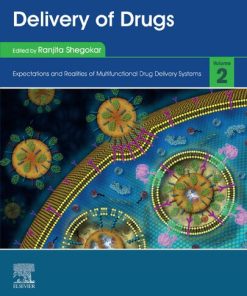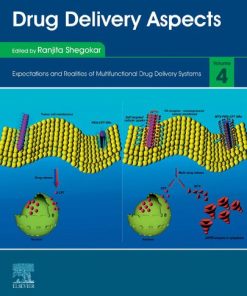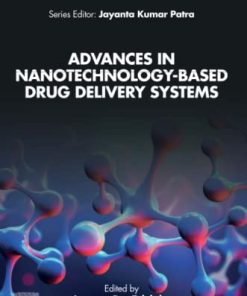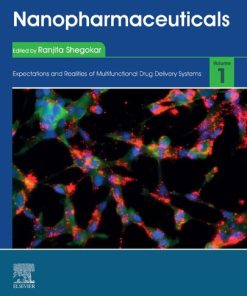Drug Delivery Trends Volume 3 Expectations and Realities of Multifunctional Drug Delivery Systems 1st Edition by Ranjita Shegokar 0128178713 9780128178713
$50.00 Original price was: $50.00.$25.00Current price is: $25.00.
Drug Delivery Trends: Volume 3: Expectations and Realities of Multifunctional Drug Delivery Systems 1st Edition by Ranjita Shegokar – Ebook PDF Instant Download/DeliveryISBN: 0128178713, 9780128178713
Full download Drug Delivery Trends: Volume 3: Expectations and Realities of Multifunctional Drug Delivery Systems 1st Edition after payment.
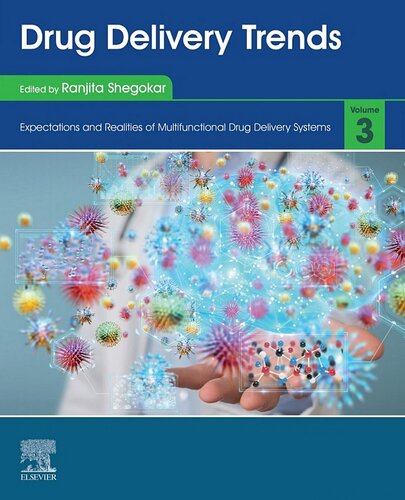
Product details:
ISBN-10 : 0128178713
ISBN-13 : 9780128178713
Author : Ranjita Shegokar
Drug Delivery Trends examines a drift in the pharmaceutical field across the wide range of dosage forms, drug delivery systems (micro and nanoparticulate), at the regulatory front and on new types of therapies in the market. This volume additionally covers the challenges on drug delivery systems in terms of preclinical and current ways of determining quality and the options to solve the challenges associated with this. Most small-medium scale industries and academics struggle with initial regulatory challenges so a detailed discussion on regulatory trend covers the necessary basic understanding of regulatory procedures and provides the required guidance.
The series Expectations and Realities of Multifunctional Drug Delivery Systems examines the fabrication, optimization, biological aspects, regulatory and clinical success of wide range of drug delivery carriers. This series reviews multifunctionality and applications of drug delivery systems, industrial trends, regulatory challenges and in vivo success stories. Throughout the volumes discussions on diverse aspects of drug delivery carriers, such as clinical, engineering, and regulatory, facilitate insight sharing across expertise area and form a link for collaborations between industry-academic scientists and clinical researchers.
Drug Delivery Trends: Volume 3: Expectations and Realities of Multifunctional Drug Delivery Systems 1st Table of contents:
Chapter 1. Bioactive hybrid nanowires: a new in trend for site-specific drug delivery and targeting
1. Introduction
2. Types of nanowires
3. Production methods
4. Applications of nanowires
5. Conclusions
Chapter 2. Opportunities and challenges of 3D-printed pharmaceutical dosage forms
1. Introduction
2. Materials
3. Technology details
4. Regulatory and quality considerations
5. Pharmaceutical applications for drug delivery
6. Conclusions
Chapter 3. Marketing authorization and licensing of medicinal products in EU: Regulatory aspects
1. Introduction
2. European Union legal framework, hierarchy, and committees
3. Legal framework for licensing medicines for human use in the EU
4. Conclusion
Chapter 4. Clinical considerations on micro- and nanodrug delivery systems
1. Introduction
2. Outline of drug development
3. Micro- and nanoparticles in drug delivery
4. Applications of micro- and nanoparticles
5. Regulatory aspects of nanotechnology-based products
6. Conclusion
Chapter 5. Nanoparticulate treatments for oral delivery
1. Introduction
2. Need for nanotechnology in oral solid dosage forms
3. Formulation perspectives
4. Challenges
5. Conclusions
Abbreviations
Chapter 6. Pharmaceutical mini-tablets: a revived trend
1. Introduction
2. Advantages of mini-tablets
3. Manufacturing
4. Types of mini-tablets
5. Methods of manufacturing mini-tablets
6. Challenges in the manufacturing of mini-tablets
7. Coating of mini-tablets
8. Fluidized-bed coating of mini-tablets
9. Pan coating of mini-tablets
10. Novel coating technology for mini-tablets
11. Packaging of mini-tablets
12. Encapsulation of mini-tablets into capsules
13. Unit-dose packing of mini-tablets into sachets
14. Conclusion
Chapter 7. Liquid crystalline drug delivery systems
1. Introduction
2. Preparation of LC systems
3. Characterization of liquid crystalline phases
4. Applications of liquid crystalline systems
5. Conclusion
Chapter 8. Amorphous drug stabilization using mesoporous materials
1. Background
2. Introduction
3. Mesoporous materials
4. Structural characterization of mesoporous materials
5. Mesoporous materials in drug delivery
6. Different forms of the loaded drug: monolayer versus pore filling
7. Drug loading techniques
8. Performance of drug-loaded mesoporous materials
9. Conclusion
Chapter 9. “Quality” of pharmaceutical products for human use—underlying concepts and required practices
1. Introduction
2. In vivo testing (clinical studies)
3. In vitro assessments or drug dissolution testing
4. Linking in vitro dissolution results to in vivo characteristics/IVIVC
5. Regulatory standards and requirements
6. Limitations and deficiencies of the current practices and requirements for quality assessment
7. Future outlook
8. Conclusions
Chapter 10. Optimizing intraperitoneal drug delivery: pressurized intraperitoneal aerosol chemotherapy (PIPAC)
1. Introduction
2. Optimizing drug therapy in peritoneal metastasis
3. Limitations of intraperitoneal chemotherapy
4. Understanding drug uptake into peritoneal nodes
5. Pharmacokinetics aspects of intraperitoneal chemotherapy
6. Pharmacodynamic aspects in intraperitoneal chemotherapy
7. Pharmacological interventions to increase drug uptake
8. Role of formulation
9. Physical interventions to improve drug uptake
10. Specifications for an ideal intraperitoneal drug delivery system
11. Peritoneal aerosol medicine
12. Pressurized intraperitoneal aerosol chemotherapy
13. Electrostatic precipitation pressurized intraperitoneal aerosol chemotherapy
14. Chemotherapeutic agents used as PIPAC
15. Preclinical studies
16. Combination of PIPAC with systemic chemotherapy
17. In silico modeling
18. Conclusion and outlook
Chapter 11. Upscaling and GMP production of pharmaceutical drug delivery systems
1. Scalability
2. Sustainability
3. GMP compliance
4. Conclusion
People also search for Drug Delivery Trends: Volume 3: Expectations and Realities of Multifunctional Drug Delivery Systems 1st:
microneedles for drug delivery trends and progress
recent trends in novel drug delivery system
recent trends in drug delivery systems
current trends in drug discovery development and delivery
emerging trends in inhaled drug delivery
Tags: Delivery Trends, Expectations, Realities, Multifunctional Drug, Ranjita Shegokar
You may also like…
Medicine - Molecular Medicine
Natural polysaccharides in drug delivery and biomedical applications 1st Edition
Technique - Nanotechnology
Medicine - Natural Medicine
Herbal Bioactive-Based Drug Delivery Systems: Challenges and Opportunities 1st Edition
Technique - Nanotechnology
Technique - Nanotechnology
Advances in Nanotechnology-Based Drug Delivery Systems Anupam 0323884504 9780323884501
Medicine - Molecular Medicine





